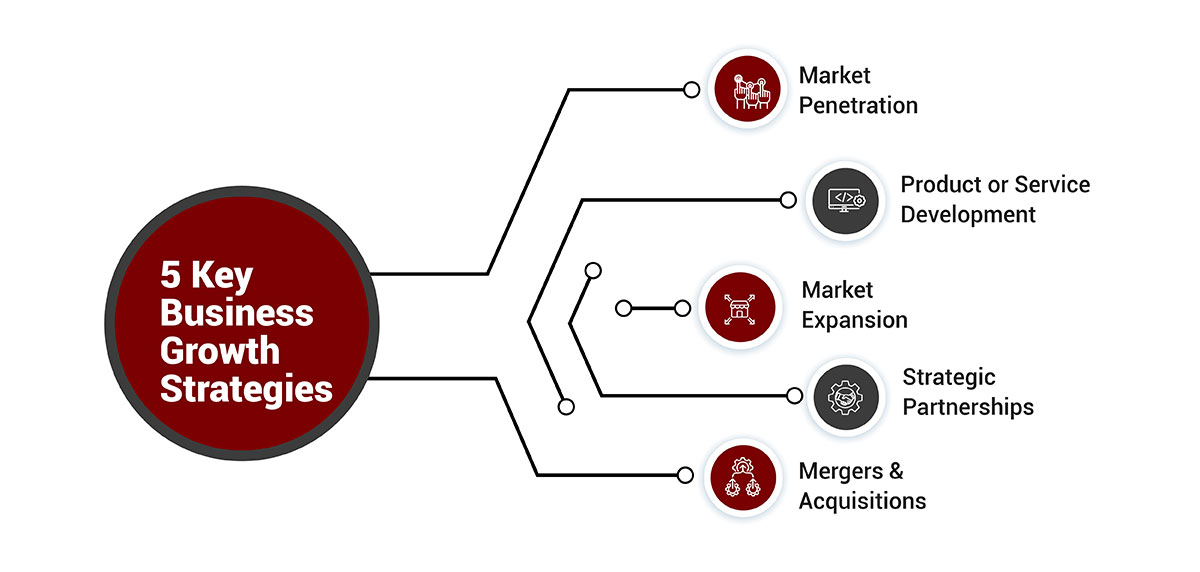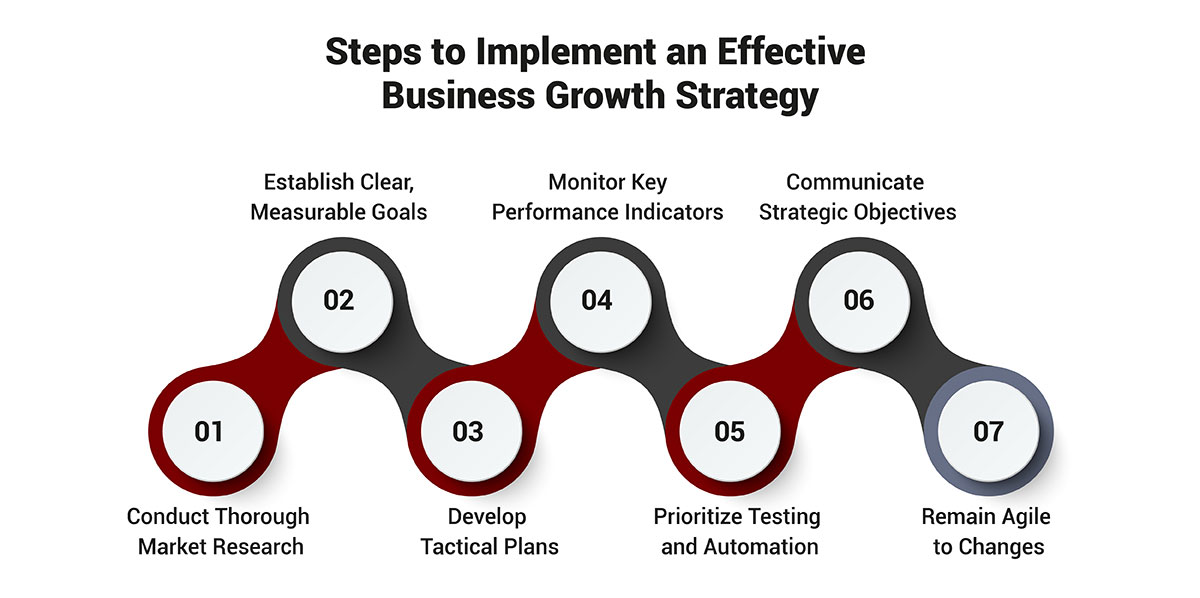5 Effective Business Growth Strategies for Scaling in the Modern Economy
 September 09, 2024
September 09, 2024
In today's dynamic business environment, constant innovation and adaptation are required to thrive. Consumer preferences and technologies are rapidly evolving, requiring businesses to constantly seek opportunities for growth. This presents both challenges and opportunities for companies of all sizes. A clear, comprehensive growth strategy is essential to effectively navigate these changes and propel an organization forward.
This article will explore 5 key business growth strategies that can help businesses sustain momentum in today's modern landscape. We will define each strategy and provide practical tips for implementation. Whether you lead a small startup or a major corporation, identifying the right mix of strategies tailored to your unique strengths and goals is important for long-term success. Let's begin!
What is a Business Growth Strategy?
A business growth strategy refers to a well-defined plan or set of tactics used to achieve measured expansion and increased success over time. It clearly outlines how a company intends to grow its revenue, market share, customer base, or geographical footprint through various approaches and tactics.
Effective business growth strategies are crucial for any company seeking to remain competitive and maximize long-term viability. They provide focus and direction toward clearly defined business goals. Without a clearly articulated growth strategy, it is difficult for a business to navigate market changes and capitalize on opportunities for advancement.
When developing a business growth strategy, companies should consider their desired growth targets in relation to financial objectives like revenue, profitability, and fundraising milestones. But non-financial metrics relating to brand awareness, customer base expansion or market leadership are also important to include. The right growth strategy will depend on a company's unique strengths, resources, and ambitions.
5 Key Business Growth Strategies
There are many approaches a company can take to achieve growth, but some of the most commonly employed strategies include:

-
1.
Market Penetration
A market penetration strategy involves capturing a larger share of your existing market through more effective marketing of your current products or services to your current customer base. Tactics may include special promotions, improved customer service, or expanded distribution channels to drive repeat purchases from loyal customers.
For example, a restaurant could implement a frequent diner rewards program or delivery partnerships like DoorDash to increase visits from established patrons. This requires deep knowledge of customers to appeal directly to their needs and preferences.
-
2.
Product or Service Development
Developing new products and services allows businesses to meet the evolving needs of existing customers as well as attract new ones. It requires investing in research, testing, and rollout of innovations that customers will genuinely value.
For instance, expanding a product line with premium or value-focused options based on market insights. Or a software company adding new features based on user feedback. This growth strategy opens doors for premium pricing and follows industry trends closely.
-
3.
Market Expansion
Entering new geographic markets or targeting new customer segments represents an opportunity to increase the total addressable market and reduce dependency on a single region or clientele base. It often involves researching untapped opportunities, and then tailoring offerings to suit local demand.
A great example is online retailer Wayfair starting to sell industrial supplies along with home goods to take advantage of synergies in supplier relationships and fulfillment infrastructure already in place. Expanding the target audience grows the business reach.
-
4.
Strategic Partnerships
Collaborating with complementary companies through promotional partnerships, joint ventures or alliances can help businesses achieve scaled growth by leveraging each other's brand recognition, resources and networks.
For instance, consumer packaged goods companies frequently partner with major retailers for co-marketing. Or an online tutoring service joining forces with universities to provide educational resources. Done right, strategic partnerships multiply opportunities.
-
5.
Mergers & Acquisitions
Acquiring other companies is a direct path to expanding market share through taking ownership of existing customers, talent and infrastructure. It can provide access to new capabilities, resources or geographic territories overnight.
Of course, M&A (Mergers & Acquisitions) also comes with substantial risks if not properly planned and integrated post-acquisition. Startups may be acquired by larger firms for access to funding and demand. Overall M&A is high risk but high reward if executed well.
Steps to Implement an Effective Business Growth Strategy
While the above strategies can drive growth when utilized individually, companies often benefit most from pursuing multiple approaches simultaneously in a harmonized manner. Here are some tips for effective implementation:

-
Conduct Thorough Market Research
The first step to effectively implementing growth strategies is conducting thorough market research. This research helps identify opportunities for growth, or "white space", that align with the company's strengths. It also allows a business to determine which of the strategic options - such as market penetration, market development, new product development, diversification, strategic partnerships, acquisitions, or disruption - are most promising based on factors like competitive landscape, customer needs, industry trends, and fit with organizational capabilities. Comprehensive market research forms the foundation for developing strategies that have the highest likelihood of success.
-
Establish Clear, Measurable Goals
Once opportunities are identified, the next step is to establish clear and measurable business goals that the growth strategies aim to achieve. These goals should follow the SMART framework - being specific, measurable, achievable, relevant, and time-bound.
Having quantifiable targets sets expectations and allows progress to be tracked over time. Short-term goals of 3-6 months allow for more frequent evaluation and adjustment if needed, while longer-term goals of 6-12 months provide direction and motivation.
-
Develop Tactical Plans
With goals defined, it's critical to develop tactical plans for implementing each growth strategy. The plans should include specifics on target metrics that align with organizational goals, such as revenue or customer acquisition goals. They should also outline functional responsibilities, resource requirements like staffing and budgets, timeline for roll-out, and activities or tactics that will be used. Having clear tactical plans helps teams successfully execute their strategies.
-
Monitor Key Performance Indicators
To effectively implement growth strategies, key performance indicators must be monitored on an ongoing basis. Tracking metrics like revenue, leads, conversions, customer retention, and more provides visibility into what is working well and what may need improvement. It allows strategies to be optimized based on data to ensure the best results.
Companies should establish a standardized process to routinely analyze performance indicators and make adjustments accordingly. Being data-driven helps maximize ROI from strategic initiatives.
-
Prioritize Testing and Automation
Testing growth strategies on a smaller initial scale before wide rollout can help reduce risk if adjustments are needed. Starting with a subsection of products, customers or regions allows strategies to be refined based on actual performance before investing significant resources company-wide.
Automating strategic components also facilitates scaling and optimization. Leveraging technology to streamline processes, analyze data insights, and engage customers enhances implementation effectiveness and efficiency over time.
-
Communicate Strategic Objectives
For strategies to be effectively implemented, their important objectives and ongoing progress are openly communicated to all stakeholders. This includes internal teams as well as external partners and others impacted by strategic initiatives. It generates understanding and buy-in which supports successful execution.
Many strategies also require collaboration across departments - communication is key to ensuring strategies are coordinated cohesively across the organization for maximum impact.
-
Remain Agile to Changes
To realize long-term goals, growth strategies must remain flexible and adaptable to changing market dynamics. Annual reviews, or reviews triggered by disruptive events, allow strategies to be re-evaluated and refined as business conditions evolve.
With today's rapid changes, agility is critical to maintain strategic alignment and pursue new opportunities. Regular assessment keeps strategies optimized for ongoing relevance and effectiveness in driving growth for the organization.
Real-world Examples of Growth Strategies in Action
Let's evaluate some real-world examples of growth strategies in action across diverse industries:
-
Market Penetration Example: Starbucks
For decades, Starbucks has prioritized penetrating existing markets, aiming to position cafés within a 5-minute walk of urban and suburban customers. This proximity and accessibility drive repeat visits from loyal patrons. Starbucks analyzes local spending, traffic and demographic data to identify new high-potential store sites.
Numerous mobile ordering and payment options plus a rewards program further encourage frequency. Customers can now order groceries for pickup from some locations extending Starbucks' relevance. This all fuels consistent same-store sales growth supporting wider global expansion efforts.
-
Product Development Example: Tesla
Electric vehicle pioneer Tesla continuously evolves its product line, having transitioned from luxury roadsters to high-performance sedans to affordable SUVs and trucks. Upgrades improve charging speeds and battery ranges to alleviate customer concerns around EV adoption.
Model refreshes introduce advanced features enabled by software updates over time, like self-driving capabilities. This builds functionality and differentiation relative to combustion rivals. Tesla also developed solar roof tiles and battery products to lead the renewable energy sector, expanding beyond its automotive roots. Such ongoing innovation drives premium pricing and demand.
-
Market Expansion Example: Netflix
Initially launching as a US DVD rental service by mail, Netflix widened its target base internationally. It now operates in over 190 countries worldwide, subtitling and dubbing content accordingly. Localization grows subscriber numbers in virgin regions still reliant on cable.
Netflix also moved into original series and films financing risky projects that likely wouldn't air elsewhere. This exclusive content differentiates the service establishing a must-see IP. Expanding into India for instance, unlocks a huge opportunity given rising internet access. Continuous territory additions fuel future growth.
-
Strategic Partnerships Example: Amazon
Jeff Bezos optimized Amazon through strategic alliances from the start, like cooperating with book publishers managing inventory and enabling one-click purchases. Partnering with major retailers to sell Amazon devices in stores expanded points of presence.
More recently, Amazon formed the AWS cloud computing division assisting enterprises with digital transformation. Integrating Alexa into third-party smart home products and vehicles augments services. Whole Foods was acquired to build out physical grocery infrastructure for final-mile deliveries. Alliances fortify Amazon's distribution channels and offerings.
-
Mergers & Acquisitions Example: Microsoft
For Microsoft, acquisitions activated critical transitions beyond packaged software into cloud services and gaming. The high-profile LinkedIn purchase accelerated its professional networking efforts versus Facebook.
When mobile threatened PCs, Microsoft acquired Nokia to bolster its handset business albeit unsuccessfully. Still, it learned iOS and Android codebases through the process, better supporting them long term.
Larger still was the Activision Blizzard merger priming more immersive interactive content for the metaverse age. Combined with Organic R&D, M&A fuels Microsoft's continuing evolution ahead of trends.
Conclusion
As illustrated, strategic growth requires understanding your business model and leveraging inherent strengths through multiple coordinated avenues. While some opportunities emerge organically, others necessitate proactive planning based on your goals and risk tolerance.
Monitoring industry shifts and customer preferences enables timely adaptation. However, pursuing growth for its own sake can dilute focus. Therefore, it’s crucial to evaluate which strategies genuinely align with and advance your core mission before implementing them. With judicious selection and data-driven oversight, your multidimensional business growth strategy can pave the way for sustainable success in changing conditions.



